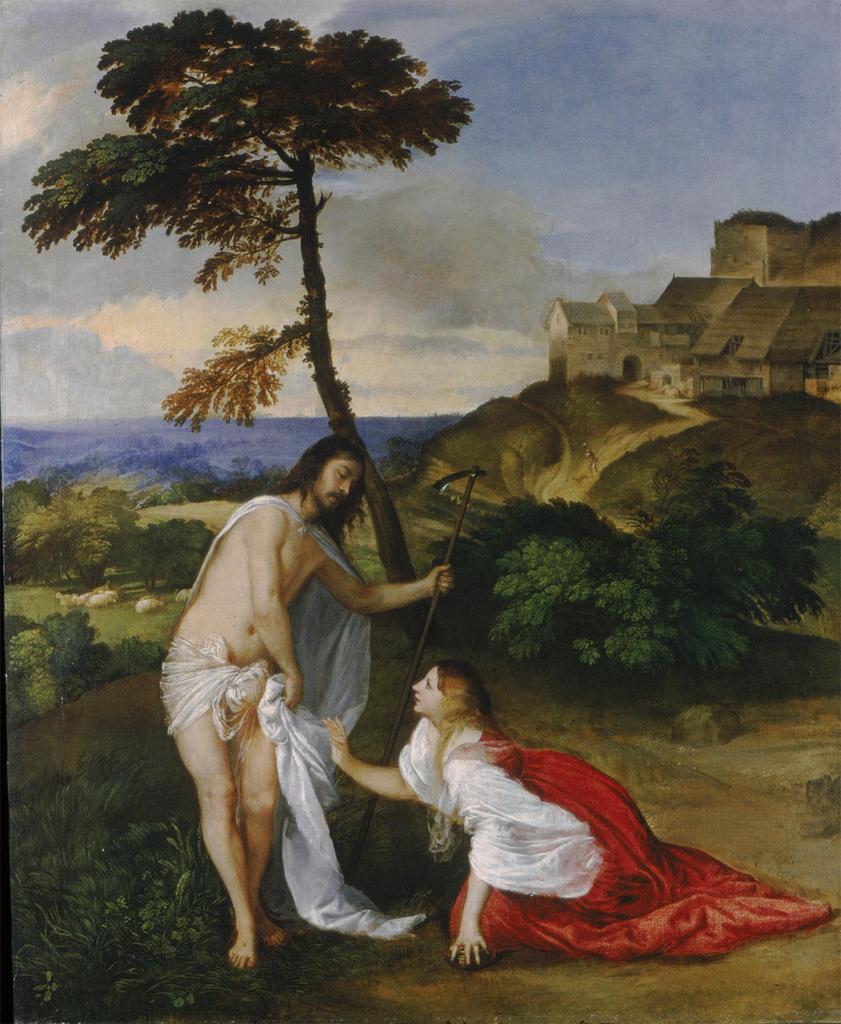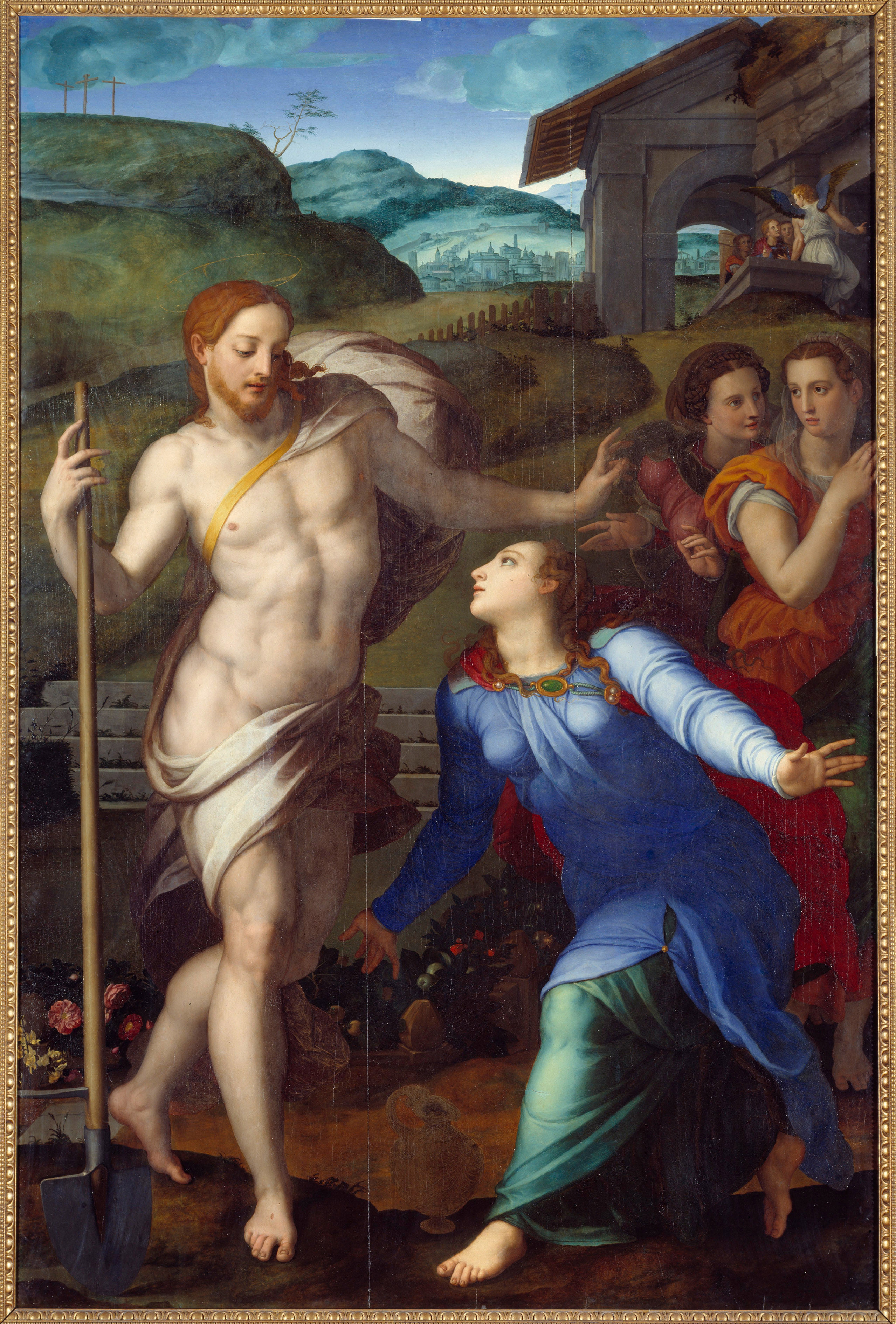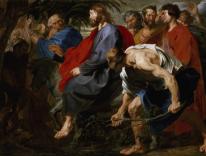No figure in the Christian pantheon except Jesus, the Virgin Mary, and John the Baptist has inspired, provoked, or confounded the imagination of painters more than the Magdalene.
The claims, speculations, and traditions that have been “hung” on Mary Magdalene often resemble in thickness and length the locks of hair that cover her body like a raccoon coat in certain medieval and early Renaissance representations. It has been said that she was once a rich woman. It has been said that she was a prostitute. It has been said that she is the same person as Mary of Bethany, that she bathed the feet of Jesus with her tears and perfumed him with ointment, that she was married to Jesus. It has been said that she was the bride of John the Evangelist at the wedding in Cana and became so jealous when her groom ran off to follow Jesus that she became a whore. It has been said that she went to Marseilles in a boat and converted the French, that she lived in a cave for thirty years and was lifted to heaven by angels seven times a day. Where beneath all the heavy and patched-up lining is Mary Magdalene? To try to “uncover” her would be rude and impossible, but it may be possible, after all that has been said, to recover, with the help of Scripture and artists, a credible human being without so many of the dubious trappings.
She is identified by name eight times in the Gospels. Three evangelists name her as having been present at the Crucifixion (Matthew 27:56; Mark 15:40; John 19:25). All four place her at the tomb of Jesus the morning of his Resurrection (Matthew 28:1–10; Mark 16:1–8; Luke 24:1–12; John 20:1–18). Luke names her as cured by Jesus of “seven demons” and as one of the women who supported him materially in his ministry (Luke 8:1–3). Her most important moment comes in John 20:1–18 when she not only is the first person to see the risen Lord but also has a conversation with him and with the attendant angels and with John and Peter. The scriptural evidence suggests that she was a loyal and close disciple, an authority by virtue of witness to the most important events in the Christian history of salvation. All four Gospels say that Jesus entrusted her with the news of his Resurrection, telling her to report it to the brothers, though Mark and Luke relate that the disciples did not believe her.
In the Latin Vulgate, the words of Jesus to Mary after his Resurrection (John 20:17) are given as Noli me tangere, translated into English, including in the King James Version, as “Do not touch me.” It is a phrase made up of simple words with an apparently obvious meaning that has provoked an unending stream of speculation and interpretation from commentators. What did Jesus mean? Why did he say these words to one of his most devoted followers?
The explanation offered by Jesus, that he “has not yet ascended to the Father,” leaves questions. Why not a hug from a friend before he goes? Some practical and literal considerations come to mind, but there are problems with all of them. Jesus may still be hurting after the scourging and Crucifixion and cannot bear to be touched even gently. Yet in John 20:27 he tells Thomas to put his hand in his wounds as proof that he is really there. Perhaps the risen Jesus is an apparition with no body—but in Luke 24:37 he invites all his disciples, not only Thomas, to “touch” him and feel that he is not a ghost. Perhaps Jesus is in a hurry to go to the Father—but he actually remains on earth for another forty days visiting people. Perhaps Jesus worries, like other rabbis of the day, that the touch of a woman will defile him—but the Jesus of the Gospels is incorruptible. Perhaps Jesus thinks that Mary’s passion has gotten the better of her and that her gesture may verge on the indecent, that she is not just saying hello but lunging passionately at him. Yet Jesus spent much of his public ministry with common folk and sinners; why would he be squeamish at this point?
If one adopts the more accurate translation of Jesus’ words, “Do not cling to (hold on to) me,” the options become somewhat clearer. The fact that he is risen does not mean that he will remain forever in the flesh with his friends and followers. They must see that he has risen bodily from the dead and therefore can raise others, but they must also learn to get along without depending on his physical presence. He still has this lesson to teach, and he would like Mary Magdalene to help him by being independent and faithful enough to go without him to the “brothers” and tell them what she has witnessed and what he has said. If one accepts this reading—certainly the one that follows most logically from the context—Jesus chose Mary Magdalene, before all the other disciples, not only to be the first to see him risen from the dead but to act as a teacher to the teachers, apostle to the apostles, apostola apostolorum.
From the earliest days of Christianity commentators on John 20 have been ingenious in their capacity to ignore or distort the narrative facts in order to produce readings that turn the text, not to mention the teachings of Jesus, to their own purposes. In the fourth century, Ambrose, the bishop of Milan and teacher of Augustine, explained in a homily that when Jesus told Mary Magdalene not to touch him, he really meant that women should not preach or teach in church:
So what does Noli me tangere mean? Do not put your hand on things too great, but go to my brothers, those who are more perfect.... The Resurrection is not so easily understood except by the perfect; the prerogative of such faith is reserved to those who are most sure. I do not permit women to teach in church; they can ask questions of their husbands at home.... Why then was Thomas allowed to touch Christ? He did not doubt the resurrection of the dead, but only the nature of the Resurrection.
In a homily in 591, the learned, holy, and influential Pope Gregory the Great spoke for the church when he established the tradition of the “composite” Magdalene, accepted in the Christian West for more than a thousand years. He placed emphasis not on Mary as a witness and friend of Jesus but on Mary the repentant sinner, whose sins were distinctly sexual and feminine:
We believe that this woman is Luke’s female sinner, the woman John calls Mary, and that Mary from whom Mark says seven demons were cast out. And what did these seven devils signify, if not all the vices?... It is clear, brothers, that the woman previously used the ointment to perfume her flesh in forbidden acts.... She had coveted with earthly eyes, but now through penitence these are consumed with tears. She displayed her hair to set off her face, but now her hair dries her tears.... She turned the mass of her crimes to virtues.
For many commentators and preachers, as apparently for Gregory, not only was the penitent Mary joined to Mary the disciple and witness, but penitence took over her entire identity until her image became fixed in a permanent state of hysterical self-recrimination and fawning at the feet of Jesus. Susan Haskins has noted that “from the thirteenth century, the penitent Magdalene became the most popular image of the saint in Italy.” The very name, Magdalene/Maudlin, came to mean “given to excessive weeping and sentimentality.” Representations of the inconsolable penitent extended beyond Italy and the Continent. In the Digby Mary Magdalene, an elaborate fifteenth-century English morality play, Mary weeps and sighs outside the tomb of Jesus: “Alas, I may no longer abide / For the dolor and distress that dwell in my heart.” When Jesus appears and calls her by name, she behaves like Gregory’s “Luke’s female sinner”: “Ah! Gracious Master and Lord, you it is that I seek! / Let me anoint you with this sweet balm! / Lord, long have you hidden yourself from me, / But now I will kiss you for my heart is beating!” Little wonder, according to this embellished version of the biblical account, that Jesus recoils, saying, “Touch me not, Mary!” since it seems as though the ever-penitent, over-passionate sinner intends to make a scene.
Most sixteenth-century Reformation and Counter-Reformation preachers continued to treat (or, more often, dismiss) Mary as a repentant sinner, a weepy female, and unreliable witness. Martin Luther thought that “by themselves, women are absurd and foolish…[therefore in presenting Mary and the other women at the tomb] the Evangelist wanted to indicate that the Gospel brings this immense treasure for us, even if we are weak.” John Calvin had a clear and simple explanation for Noli me tangere; he doubted that Mary remained alone at the tomb:
We need not praise the women because they remained at the sepulcher while the disciples returned home; for the latter went home comforted and full of joy, whereas the women indulged themselves in pointless and stupid weeping. What kept them at the tomb was mere superstition, together with the feelings of the flesh.... Now, since Christ allowed himself to be touched by his disciples, why did he forbid Mary? The answer is easy, if only we remember that Jesus did not repel them until they overdid their desire to touch him.... The truth is that Jesus did not forbid them to touch him until he saw their stupid and excited desire to keep him here on earth.
By grouping Mary Magdalene with the other women at the tomb of Jesus, male commentators relieved themselves of having to dwell on the intimacy (and possible awkwardness and importance) of a personal and private exchange between the risen Lord and Mary, and they also erased her singularity, identifying her as a stereotypical woman, “weak,” “stupid,” much given to “weeping” and “the feelings of the flesh.”
Since Mary Magdalene and especially the scene with Jesus in the garden outside his tomb were fraught with various and contradictory interpretations, it is fascinating to see how painters “read” Noli me tangere. In decorating the cells of the Dominican monastery of San Marco in Florence, Fra Angelico and his assistants chose the encounter as the subject for cell number one. In this depiction (designed by Fra Angelico but probably painted by his assistant Benozzo Gozzoli in 1440), Jesus—who the Gospel says was mistaken by Mary for a gardener—carries a hoe; he could be saying to Mary that he has “work” to do and cannot stop to chat. If so, the artist managed to endow this matter-of-fact moment with a magnificent spiritual serenity. Mary is not weeping or visibly shaken by the sight of Jesus. She kneels in dignified reverence and her gesture is a refined combination of greeting and prayer. She is neither forward nor humble, but rather balanced in an attitude of recognition, regard, and self-composure. Despite the fact that his linen wrapping is supposed to have been left in the tomb, Jesus is fully clothed in stainless white robes, and the position of his feet suggests that he is already beginning his ascent to heaven. He looks at Mary with regal kindness; his hoe could be a scepter or standard. There is no sign of displeasure or suppressed desire. Indeed, the elegant postures and pleasant exchange of looks suggests a minuet in which each partner knows his and her role. This is not a shocking or disturbing scene in which Mary overreacts but a quiet beginning of a heavenly dance.

Fra Angelico’s Magdalene has a halo and a blessed calm. Her sins have been forgiven, and one might even say that, in this painting, they have been forgotten. Sixteenth-century artists more often preferred to revisit the penitent sinner and imagine her meeting with Jesus at the tomb in ways that emphasized the physical beauty of the two figures and a dramatic, if momentary, conflict of perspective and intention. In an early painting (above), Titian displays his great skill in representing the human form expressing emotion. It could hardly be more different from the San Marco fresco.
Once again, the scene suggests a dance, but here Jesus appears to play the role of the female partner, elegantly curtsying while modestly attempting to cover himself and avoid the touch of the woman kneeling as if she is making a proposal (or proposition). Mary is literally forward in the painting; her expression is imploring; her long hair and gorgeous red cloak are reminders of her former life of luxury. John’s Gospel does not specify how or where Mary intended to touch Jesus, but painters cannot avoid the details. Titian leaves little doubt that, whatever her intentions, Mary was coming very close to the Lord’s genitals. This is clearly what Titian’s Jesus fears, as his gesture indicates. The painting lends an obviously erotic element to the episode.

Titian was by no means the last to weave natural human elements—physical beauty and sexual potential—into an otherwise orthodox conception of the Resurrection as narrated in the Gospel of John. In one of his last paintings (1561) for an altarpiece in the Church of Santo Spirito, Florence, Agnolo Bronzino carries the tendency a step further. Whereas in the Fra Angelico and the Titian the atmosphere is peaceful and private, the figures relatively calm and dignified, in Bronzino’s painting (above) the mood is theatrical, even melodramatic. Both Jesus and Mary Magdalene appear aroused, although in different ways, and they are not alone. There is an audience. Not only are there women and an angel still at the tomb in the background (perhaps representing an earlier moment in the story), but two women also hover near the leading players, gesturing, smiling, and whispering as if spying on and gossiping about the encounter.
True, the figures are twisting and turning in a way reminiscent of Michelangelo, but not everything can be blamed on Michelangelo. In more than one way, the positions of Jesus and Magdalene are the reverse of traditional depictions of the event, including a sketch by Michelangelo. A particularly young and beautiful Jesus approaches from the left (the usual entrance point of Magdalene). His red locks, delicate features, and glowing white skin seem to have borrowed some of the attributes of the repentant sinner with whom he exchanges tender looks. He appears to be running toward, not away from, Magdalene; the odd but graceful twist of his torso suggests a “turning away” that looks very much like a thrusting forward. Mary too is on the run, so much so that if both keep going (as the dynamic of their movement shows they must) they will surely collide. Although Mary’s posture and gestures are wild, she is modestly attired in sober colors and her expression is one of adoration rather than of what Calvin called “stupid excitement.”
Jesus, the “gardener,” has evidently been a good gardener. He carries a shovel, not a hoe, and from the earth behind the two friends lovely flowers bloom. In the background even the tomb is “alive” with possibility: on the right is the dark door of the sepulcher leading nowhere and on the left is an arch opening onto the soft and gorgeous hills of a landscape like paradise. Bronzino shows the Resurrection as a scene of questions, opportunities, pleasures, and risks, all in motion, like life, just as the artist or his patron, an old man facing his own death, might have liked to recall it.
Given the readiness of male commentators to read “feminine” attributes—tears, overexcitement, superstition—in Mary Magdalene’s behavior at the tomb, it is important to keep in mind the perspective of the most successful and popular woman painter of the Italian Renaissance. Lavinia Fontana studied painting with her father Prospero in Bologna in the 1560s and ’70s, supported her husband and children by painting, was invited to Rome by Pope Clement VII, painted portraits and religious scenes, and was the first woman to be invited to membership of the Roman Academy. Like all painters of the period, Fontana shows the influence of male predecessors, especially Venetians, but her rendition of the Noli me tangere (above) has several qualities that distinguish it from many others of the period and the preceding century.
Fontana’s Jesus actually looks like a gardener. It would not have been “stupid” of her Magdalene to fail to recognize him at first. He wears a big hat and a rustic outfit; he is not young, beautiful, or half-naked. He neither thrusts himself at Mary nor pushes her away. His gesture is one of paternal blessing. Mary kneels like a dutiful daughter; her expression is loving; and her arms are open in surprise and greeting. The figure of Mary is as mature and dignified as that of Jesus. There is nothing wild, disheveled, or hysterical in her appearance. She has a halo, and the perfume in her left hand seems more a sign of her identity as a saint than a prop ready for use. The scene has none of the erotic tension of Titian’s and Bronzino’s paintings. In fact, despite the women at the tomb in the background and the glow of the dawn, the dynamics and uncertainties of narrative are subsumed by an air of serene completion as if the sepia tones wash away all anxieties about the meaning of this meeting. Jesus’ extended arm and open hand suggest not only a blessing but a sending forth, a commissioning reminiscent, in pictorial terms, of his command to the apostles to go and preach the gospel. Unlike many painters, Fontana appears not to have forgotten the lines in John 20 in which Jesus bids Mary to “go to the brothers and say to them, ‘I am ascending to my Father.’”
In the documents of Vatican II, the Feast of St. Mary Magdalene on July 22 was proclaimed to be in memory “only of the one to whom Christ appeared after the Resurrection and in no sense the sister of Martha or the woman who was a sinner.” Is it too late? After all this time, the question remains whether it is or ever has been possible to “recover” a Mary Magdalene not covered in tears and shame; to see her instead as a disciple and friend of Christ’s, not necessarily married to him or clinging to him but capable of standing up straight and speaking for herself.
Painters, like the Church Fathers and Reformers, have had their own agendas, but, at the very least, they have put a human face (with more than one expression) and a body (not always covered with her hair) on their imaginary Magdalene. The woman who remained close to Jesus even at the end of his life, but was forbidden to touch him after the Resurrection, continues to make an impression. Fra Angelico and Titian, Bronzino and Lavinia Fontana may not have gotten their “Magdalenes” just right, but they all recover some human dignity, pride, and complexity for a woman who, through no fault of her own, lost her importance as a beloved friend of Jesus and her stature as “apostle to the apostles”—not to mention her virtue—in the eyes of many men and women for centuries.
This essay is adapted from Blessed and Beautiful: Picturing the Saints by Robert Kiely, to be published by Yale University Press in October.
Please email comments to [email protected] and join the conversation on our Facebook page.
Share
Previous Story
Ascension: (Psalm 102:7)
Next Story
Last Respects

